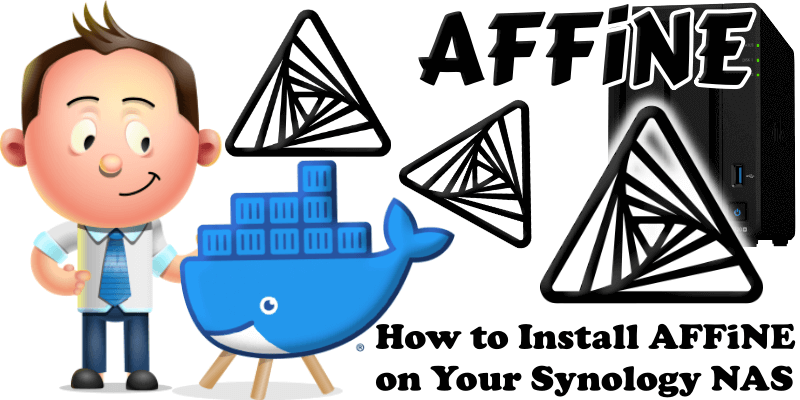
AFFiNE is a next-gen knowledge base that brings planning, sorting, and creating all together. Form your knowledge console at your wish. Open-source, privacy-first, and always free. AFFiNE is an alternative to Notion and Miro. It’s a workspace with fully merged docs, whiteboards and databases. In this step by step guide I will show you how to install AFFiNe on your Synology NAS using Docker & Portainer.
STEP 1
Please Support My work by Making a Donation.
STEP 2
Install Portainer using my step by step guide. If you already have Portainer installed on your Synology NAS, skip this STEP. Attention: Make sure you have installed the latest Portainer version.
STEP 3
Make sure you have a synology.me Wildcard Certificate. Follow my guide to get a Wildcard Certificate. If you already have a synology.me Wildcard certificate, skip this STEP.
STEP 4
Go to Control Panel / Login Portal / Advanced Tab / click Reverse Proxy. Follow the instructions in the image below.
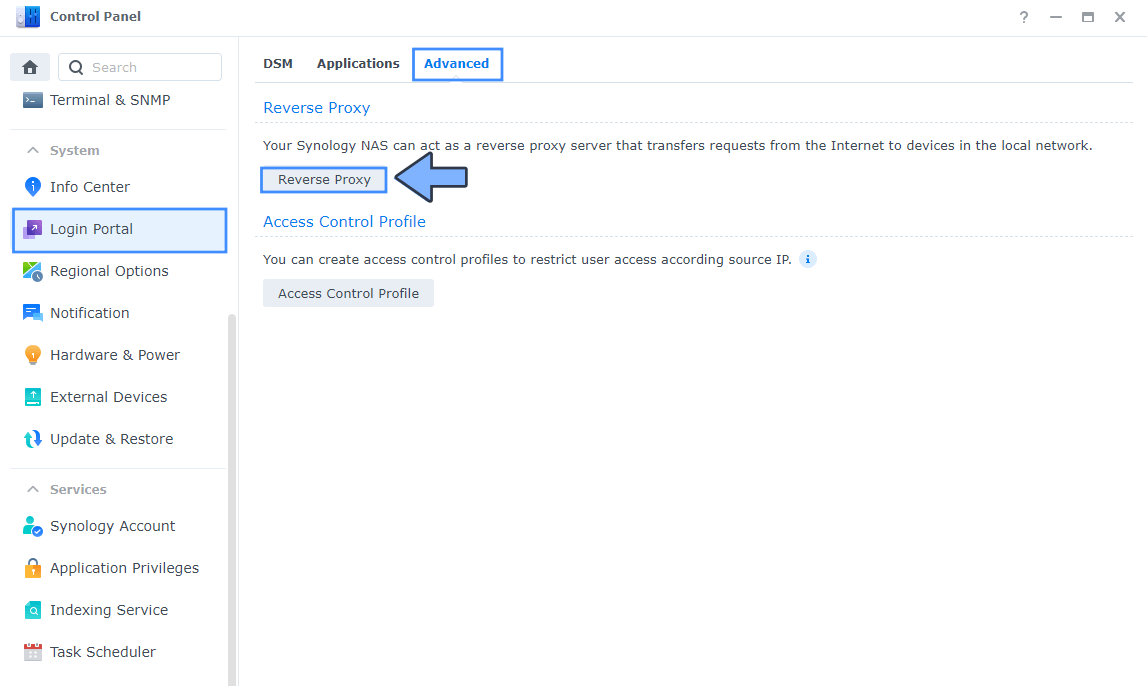
STEP 5
Now click the “Create” button. Follow the instructions in the image below.
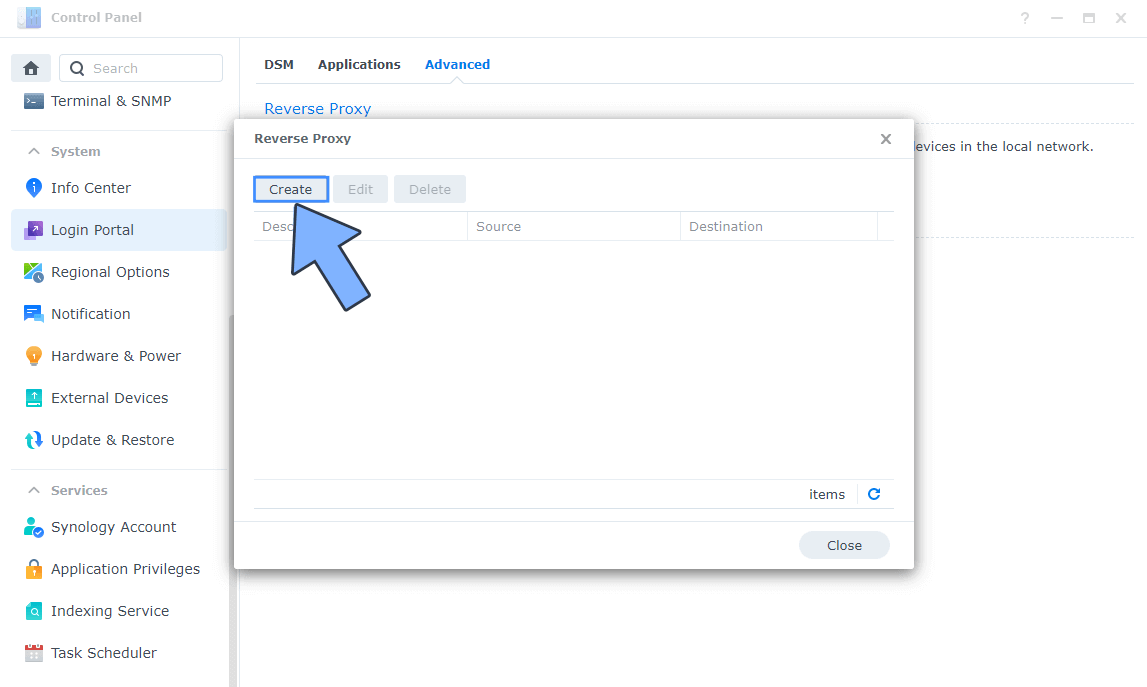
STEP 6
After you click the Create button, the window below will open. Follow the instructions in the image below.
On the General area, set the Reverse Proxy Name description: type in Affine. After that, add the following instructions:
Source:
Protocol: HTTPS
Hostname: affine.yourname.synology.me
Port: 443
Check Enable HSTS
Destination:
Protocol: HTTP
Hostname: localhost
Port: 3010
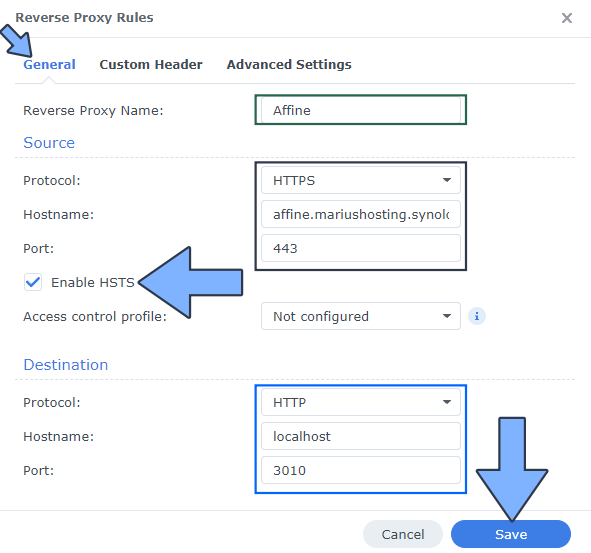
STEP 7
On the Reverse Proxy Rules click the Custom Header tab. Click Create and then, from the drop-down menu, click WebSocket. After you click on WebSocket, two Header Names and two Values will be automatically added. Click Save. Follow the instructions in the image below.

STEP 8
Go to Control Panel / Network / Connectivity tab/ Check Enable HTTP/2 then click Apply. Follow the instructions in the image below.
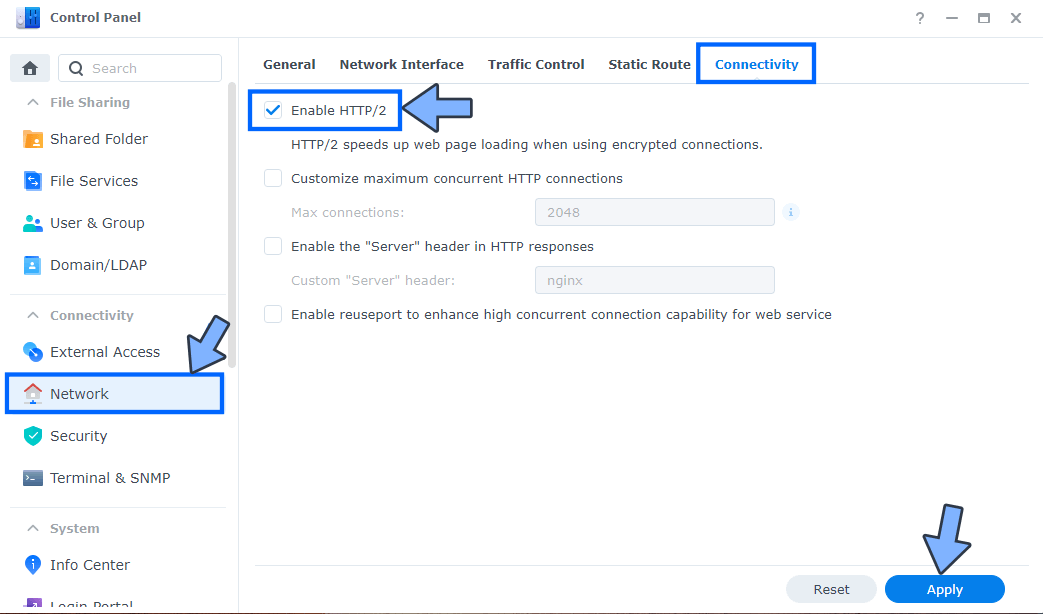
STEP 9
Go to Control Panel / Security / Advanced tab/ Check Enable HTTP Compression then click Apply. Follow the instructions in the image below.
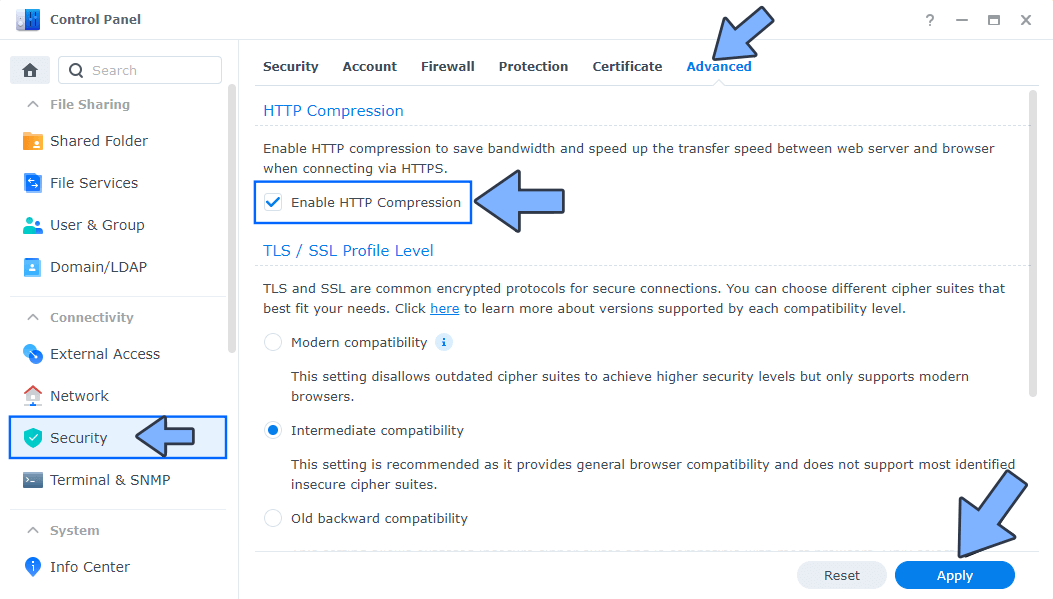
STEP 10
Go to File Station and open the docker folder. Inside the docker folder, create one new folder and name it affine. Follow the instructions in the image below.
Note: Be careful to enter only lowercase, not uppercase letters.
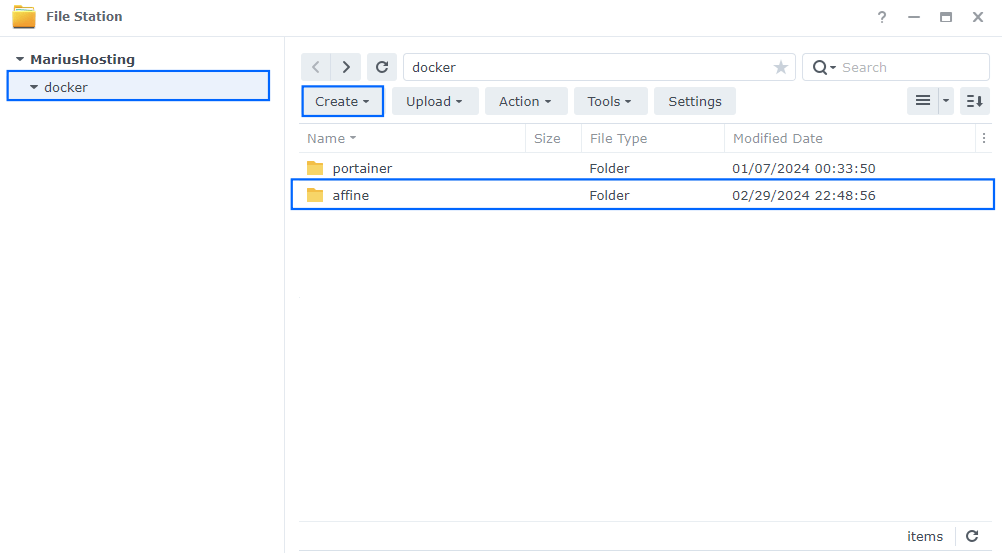
STEP 11
Now create four new folders inside the affine folder that you created at STEP 10 and name them storage, redis, db, config. Follow the instructions in the image below.
Note: Be careful to enter only lowercase, not uppercase letters.
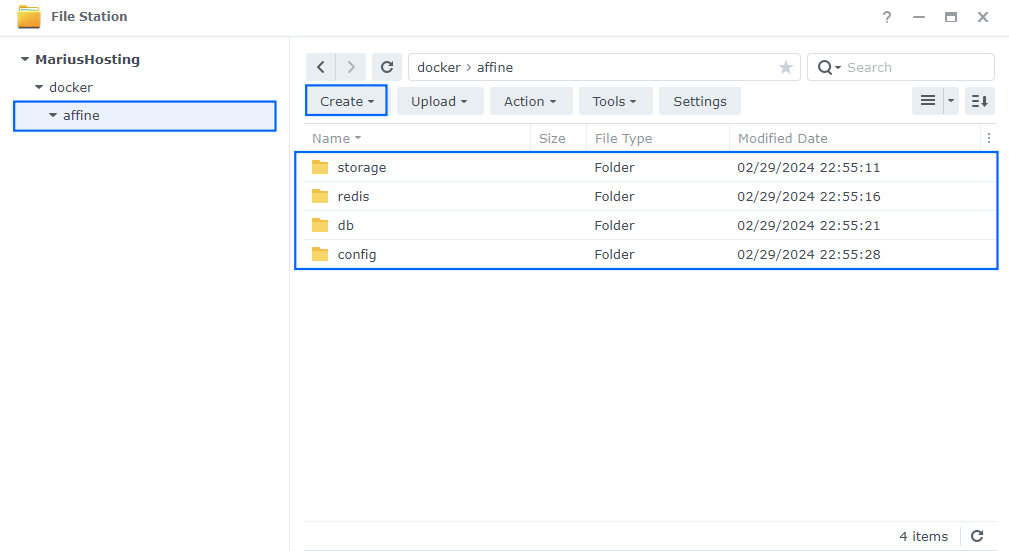
STEP 12
Follow my step by step guide on how to activate SMTP for your Gmail account. This step is mandatory. Note: If you don’t want to use the easiest way for SMTP with Google and you already have SMTP details from your own Mail Server, you can just skip this STEP and use your personalized email SMTP details instead.
STEP 13
Log into Portainer using your username and password. On the left sidebar in Portainer, click on Stacks then + Add stack. Follow the instructions in the image below.

STEP 14
In the Name field type in affine. Follow the instructions in the image below.
services:
affine:
image: ghcr.io/toeverything/affine-graphql:stable
container_name: AFFINE
healthcheck:
test: timeout 10s bash -c ':> /dev/tcp/127.0.0.1/3010' || exit 1
interval: 10s
timeout: 5s
retries: 3
start_period: 90s
ports:
- 3010:3010
depends_on:
redis:
condition: service_healthy
postgres:
condition: service_healthy
affine_migration:
condition: service_completed_successfully
volumes:
- /volume1/docker/affine/config:/root/.affine/config:rw
- /volume1/docker/affine/storage:/root/.affine/storage:rw
restart: on-failure:5
environment:
- AFFINE_REVISION=stable
- AFFINE_INDEXER_ENABLED=false
- PORT=3010
- AFFINE_SERVER_HTTPS=true
- AFFINE_SERVER_EXTERNAL_URL=https://affine.yourname.synology.me
- MAILER_HOST=smtp.gmail.com
- MAILER_PORT=465
- MAILER_USER=Your-own-gmail-address
- MAILER_PASSWORD=Your-own-app-password
- MAILER_SENDER=Affine
- REDIS_SERVER_HOST=redis
- DATABASE_URL=postgres://affineuser:affinepass@postgres:5432/affine?sslmode=disable
- NODE_ENV=production
- AFFINE_ADMIN_EMAIL=yourown@email
- AFFINE_ADMIN_PASSWORD=mariushosting
- DB_DATA_LOCATION=~/.affine/self-host/postgres/pgdata
- UPLOAD_LOCATION=~/.affine/self-host/storage
- CONFIG_LOCATION=~/.affine/self-host/config
affine_migration:
image: ghcr.io/toeverything/affine-graphql:stable
container_name: Affine_MIGRATION
volumes:
- /volume1/docker/affine/config:/root/.affine/config:rw
- /volume1/docker/affine/storage:/root/.affine/storage:rw
command: ['sh', '-c', 'node ./scripts/self-host-predeploy.js']
environment:
- REDIS_SERVER_HOST=redis
- DATABASE_URL=postgres://affineuser:affinepass@postgres:5432/affine?sslmode=disable
- AFFINE_INDEXER_ENABLED=false
- DB_DATA_LOCATION=~/.affine/self-host/postgres/pgdata
- UPLOAD_LOCATION=~/.affine/self-host/storage
- CONFIG_LOCATION=~/.affine/self-host/config
depends_on:
postgres:
condition: service_healthy
redis:
condition: service_healthy
redis:
image: redis:latest
container_name: AFFINE-REDIS
restart: on-failure:5
volumes:
- /volume1/docker/affine/redis:/data:rw
healthcheck:
test: ['CMD', 'redis-cli', '--raw', 'incr', 'ping']
interval: 10s
timeout: 5s
retries: 5
postgres:
image: pgvector/pgvector:pg17
container_name: AFFINE-DB
restart: on-failure:5
volumes:
- /volume1/docker/affine/db:/var/lib/postgresql/data:rw
healthcheck:
test: ["CMD", "pg_isready", "-q", "-d", "affine", "-U", "affineuser"]
interval: 10s
timeout: 5s
retries: 5
environment:
POSTGRES_USER: affineuser
POSTGRES_PASSWORD: affinepass
POSTGRES_DB: affine
POSTGRES_INITDB_ARGS: '--data-checksums'
Note: Before you paste the code above in the Web editor area below, change the value for AFFINE_SERVER_EXTERNAL_URL and type in your own synology.me DDNS with https:// at the beginning that you have previously created at STEP 6.
Note: Before you paste the code above in the Web editor area below, change the value for MAILER_USER and type in your own Gmail address. STEP 12.
Note: Before you paste the code above in the Web editor area below, change the value for MAILER_PASSWORD and type in your own Gmail app password. STEP 12.
Note: Before you paste the code above in the Web editor area below, change the value for AFFINE_ADMIN_EMAIL and type in your own email address. You will need this email later at STEP 21.
Note: Before you paste the code above in the Web editor area below, change the value for AFFINE_ADMIN_PASSWORD and type in your own affine password. You will need this password later at STEP 22.
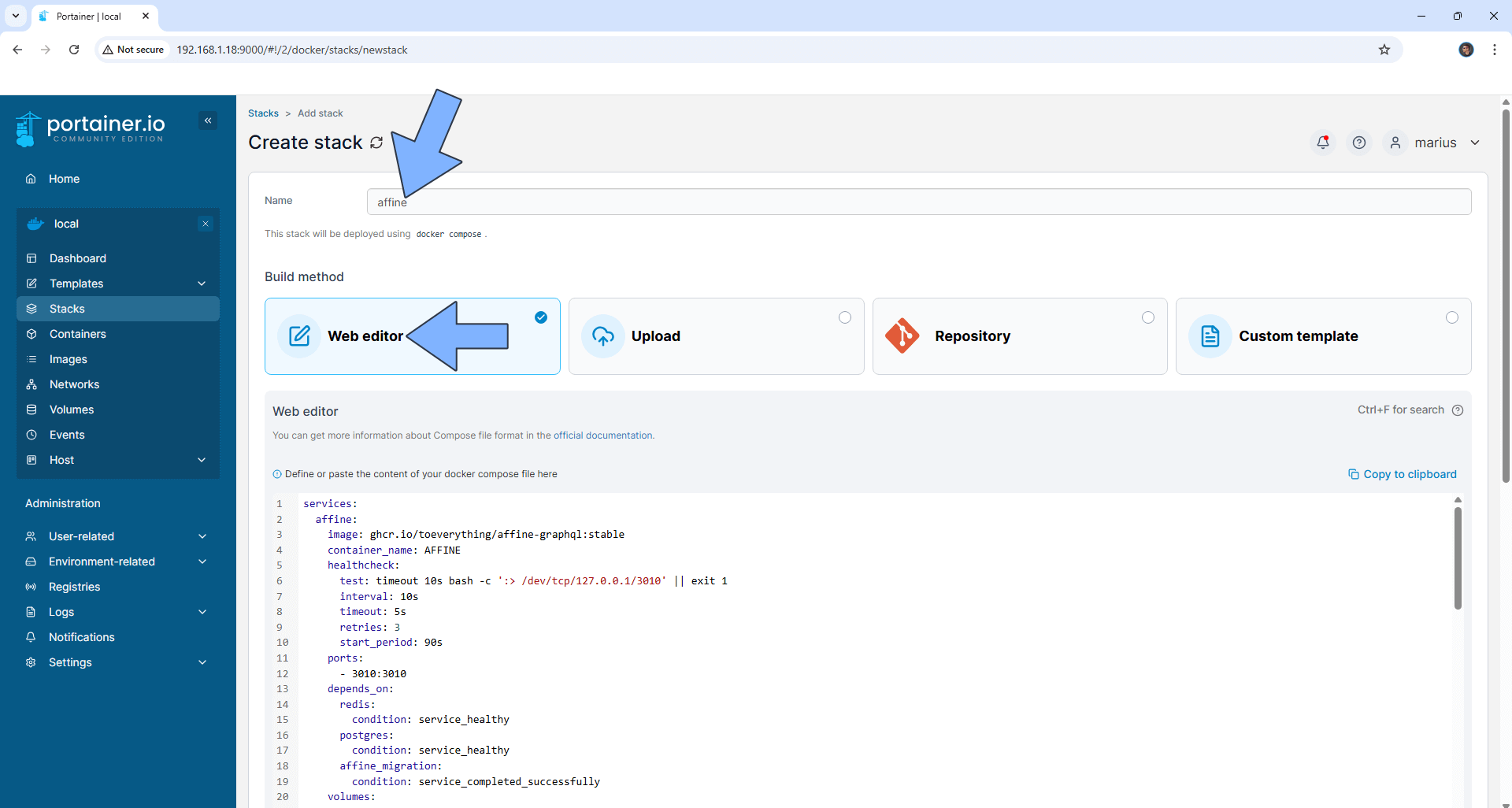
STEP 15
Scroll down on the page until you see a button called Deploy the stack. Click on it. Follow the instructions in the image below. The installation process can take up to a few minutes. It will depend on your Internet speed connection.
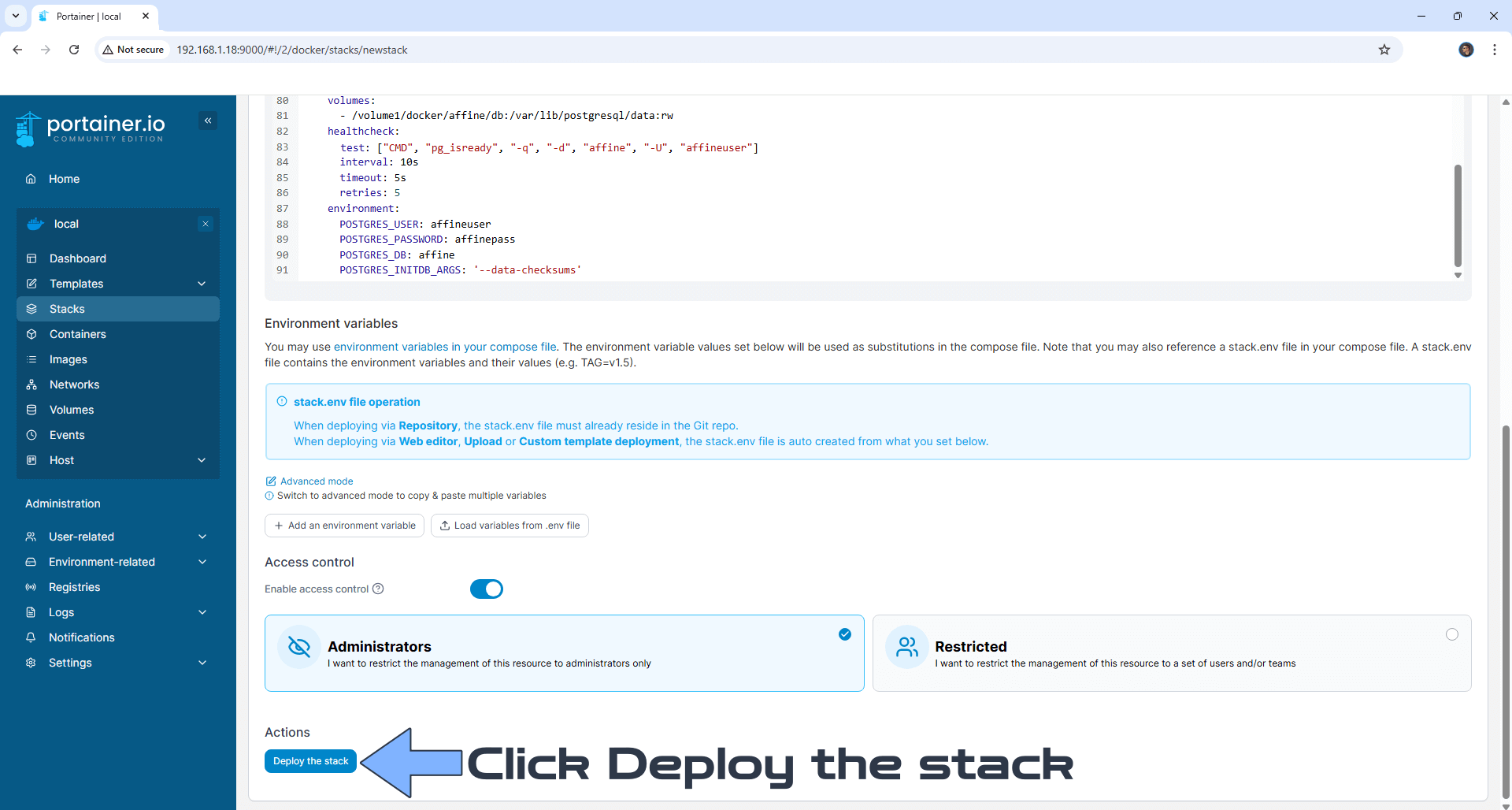
STEP 16
If everything goes right, you will see this message at the top right of your screen: “Success Stack successfully deployed“.
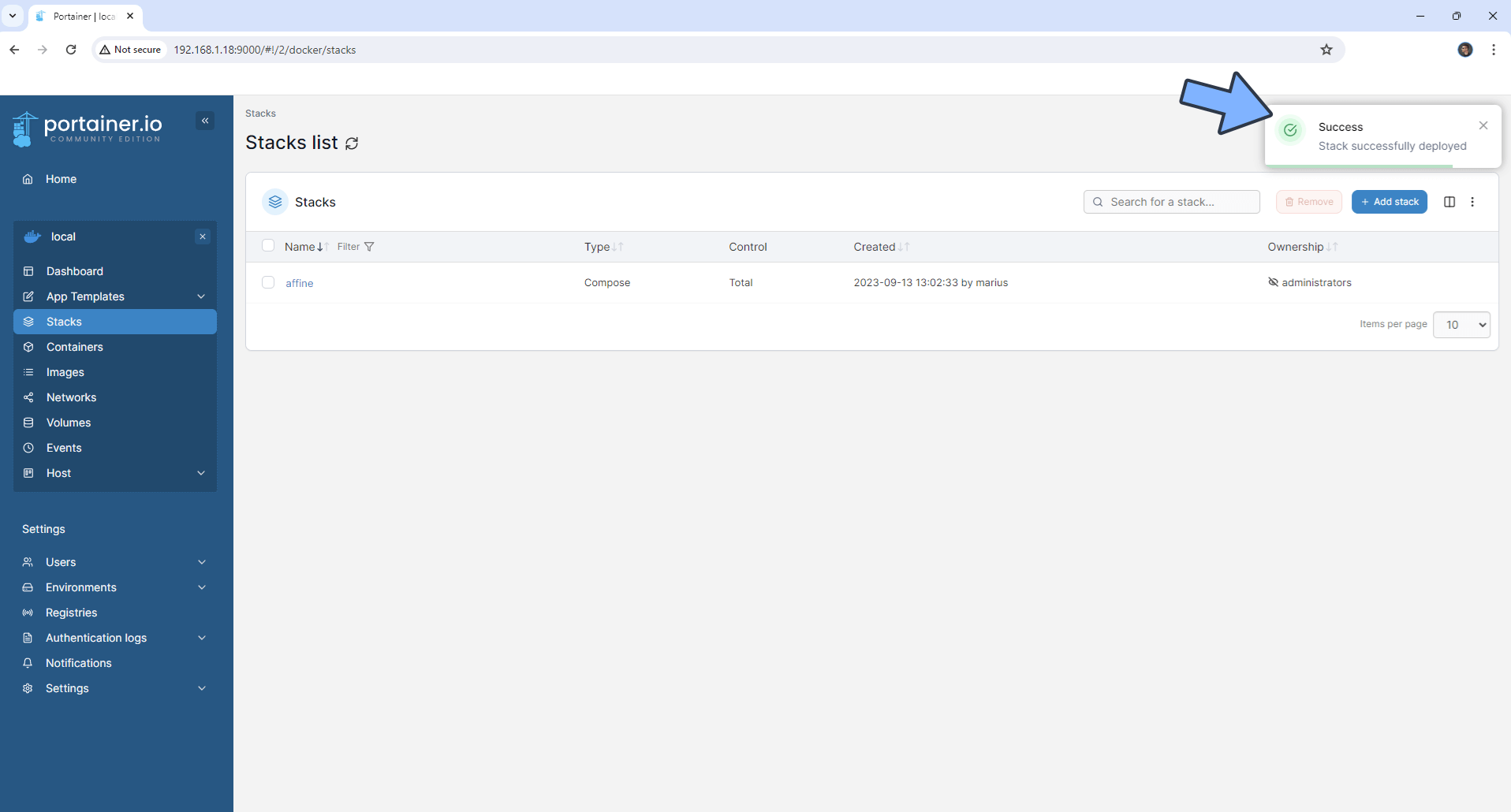
⚠️Note: After a couple of seconds/minutes, your container Affine-MIGRATION will be marked as “exited – code 0“. This is normal behavior. Go straight to the next STEP.
STEP 17
🟢Please Support My work by Making a Donation. Almost 99,9% of the people that install something using my guides forget to support my work, or just ignore STEP 1. I’ve been very honest about this aspect of my work since the beginning: I don’t run any ADS, I don’t require subscriptions, paid or otherwise, I don’t collect IPs, emails, and I don’t have any referral links from Amazon or other merchants. I also don’t have any POP-UPs or COOKIES. I have repeatedly been told over the years how much I have contributed to the community. It’s something I love doing and have been honest about my passion since the beginning. But I also Need The Community to Support me Back to be able to continue doing this work.
STEP 18
Now open your browser and type in your HTTPS/SSL certificate like this https://affine.yourname.synology.me that you have previously added at STEP 6. In my case it’s https://affine.mariushosting.synology.me Click Continue. Follow the instructions in the image below.
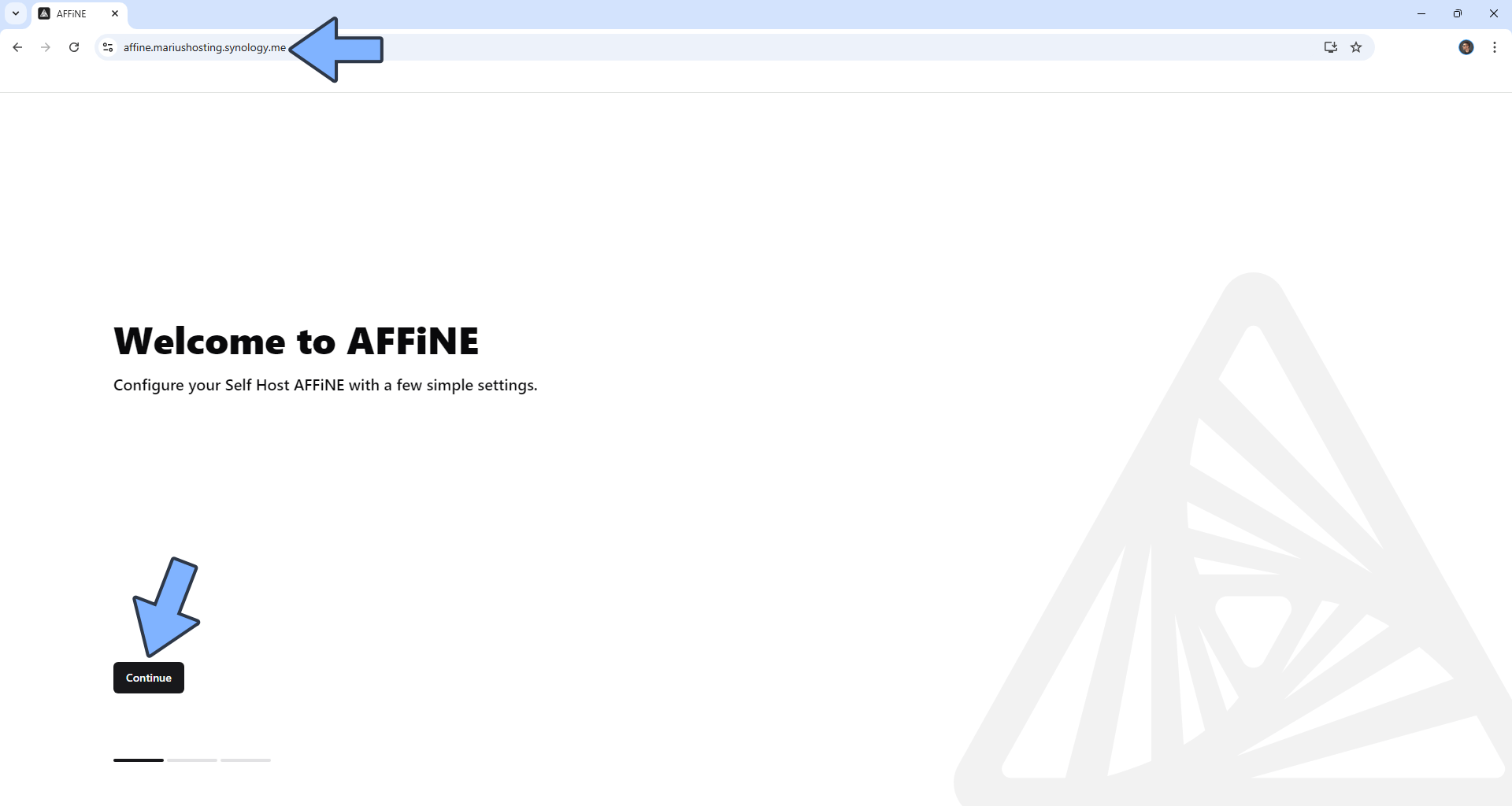
STEP 19
Add your Administrator details, then click Continue. Follow the instructions in the image below.

STEP 20
Your Administrator details at a glance!
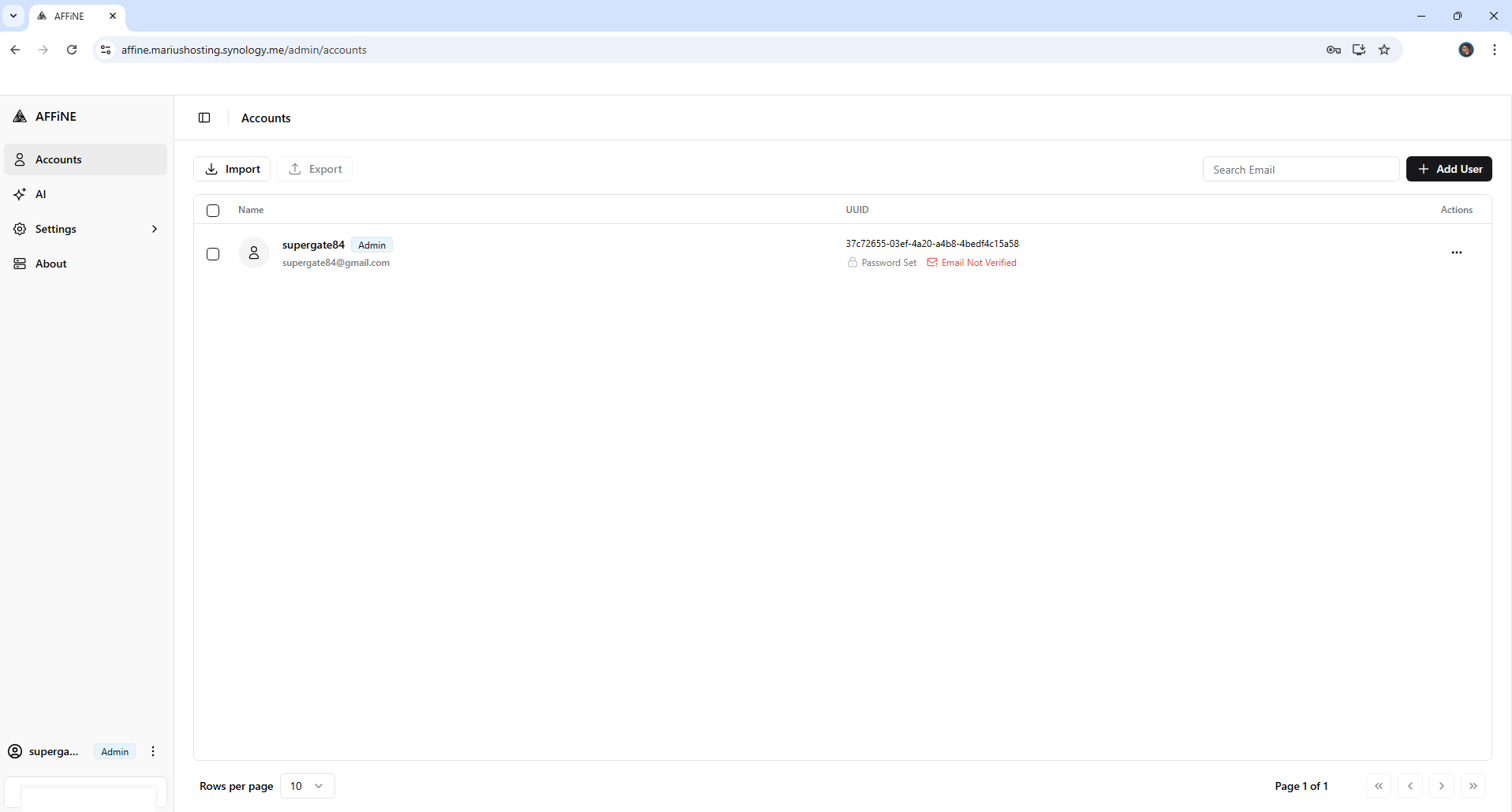
STEP 21
Now open your browser and type in your HTTPS/SSL certificate like this https://affine.yourname.synology.me/workspace In my case it’s https://affine.mariushosting.synology.me/workspace – Click Back to my Content. Follow the instructions in the image below.
Note: Your live website will be at https://affine.yourname.synology.me/workspace and your administrator dashboard will be at https://affine.yourname.synology.me/admin
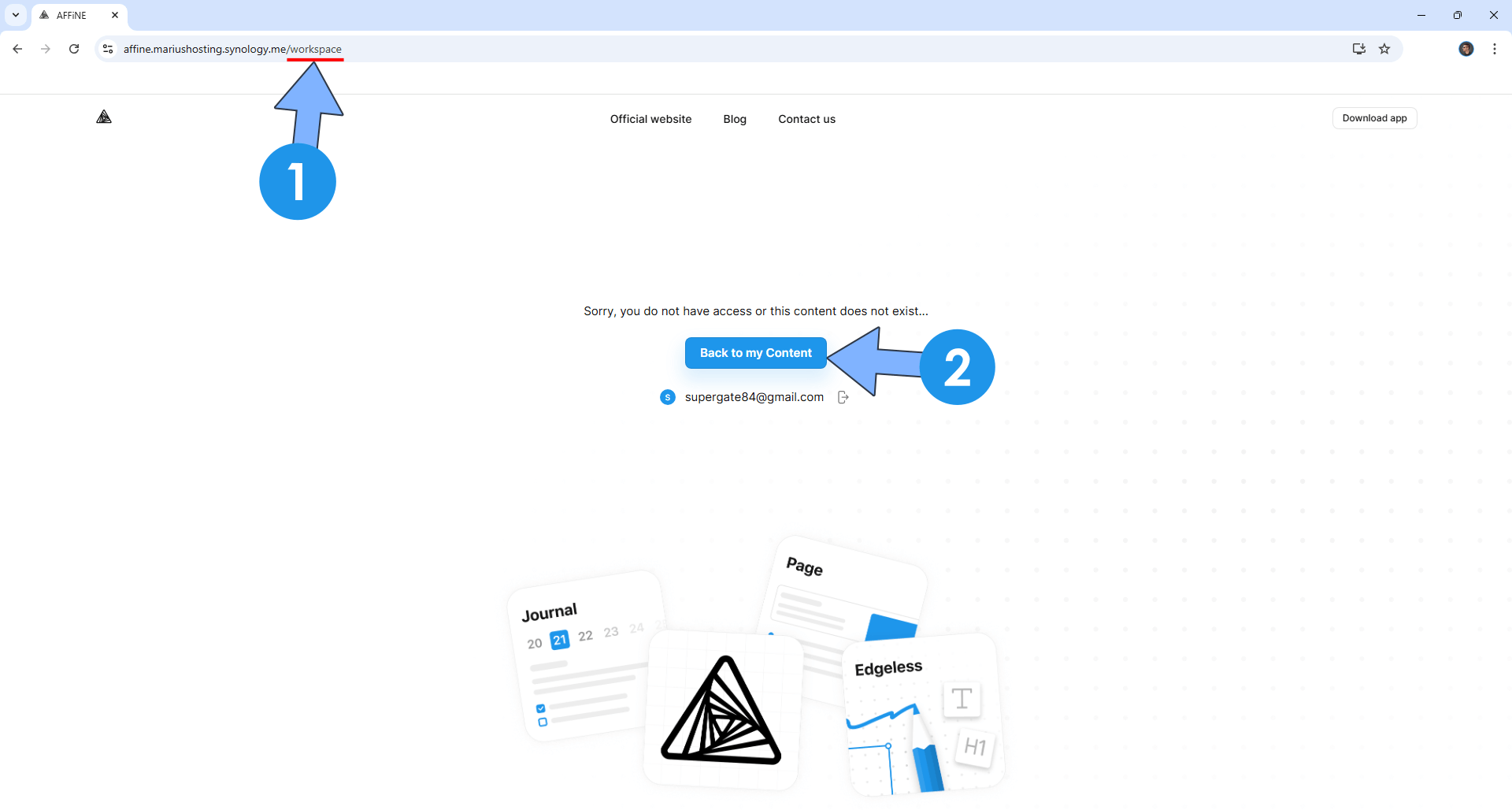
STEP 22
On the left sidebar, click Settings. Under Appearance, click Dark to switch the theme to dark. Follow the instructions in the image below.
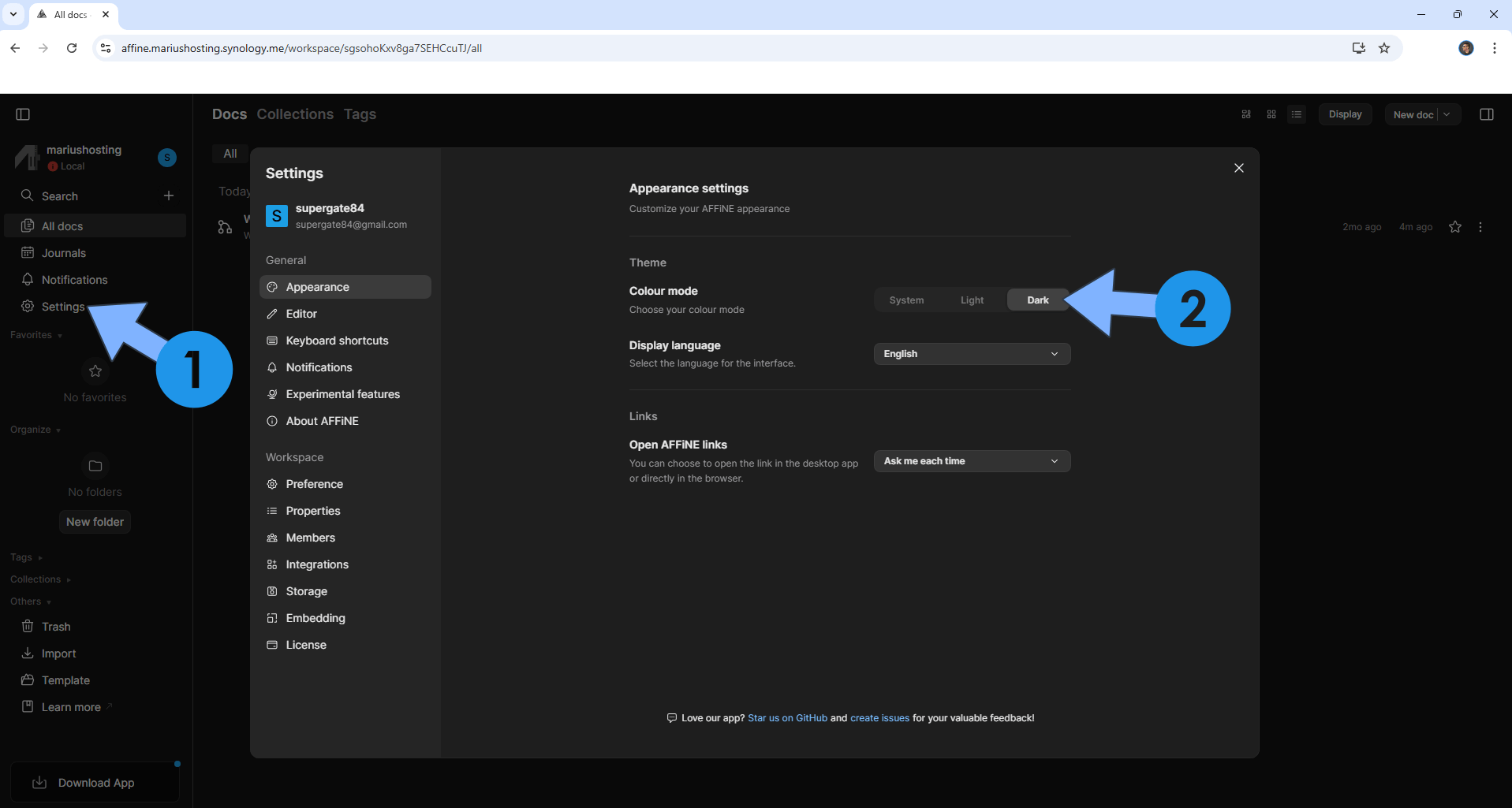
STEP 23
Click on Preference. Change your workspace icon and name. Click Save to save the settings. Follow the instructions in the image below.

STEP 24
Your AFFiNE instance at a glance!
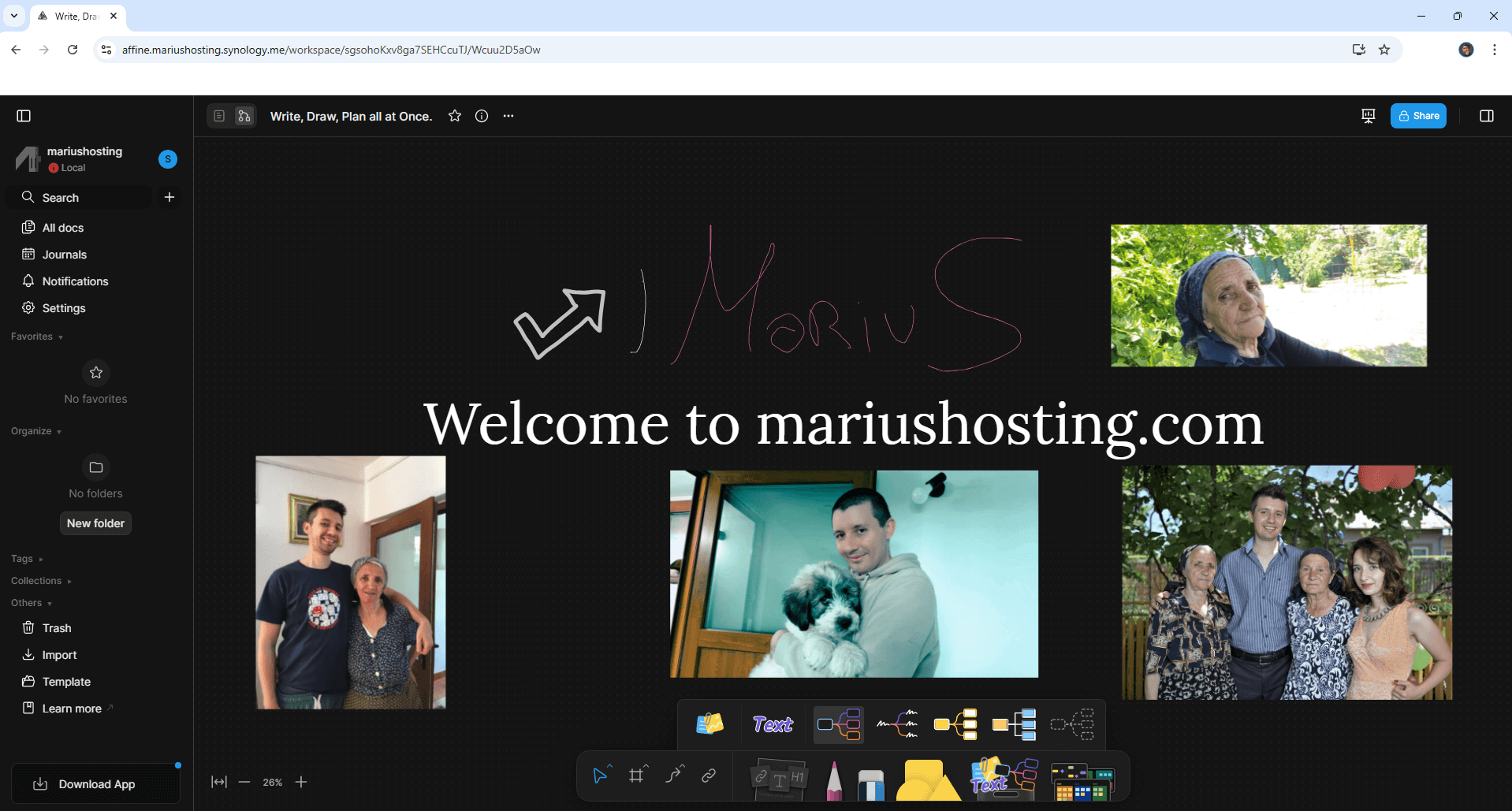
Enjoy Affine!
If you encounter issues by using this container, make sure to check out the Common Docker issues article.
Note: Can I run Docker on my Synology NAS? See the supported models.
Note: How to Back Up Docker Containers on your Synology NAS.
Note: Find out how to update the AFFiNE container with the latest image.
Note: How to Free Disk Space on Your NAS if You Run Docker.
Note: How to Schedule Start & Stop For Docker Containers.
Note: How to Activate Email Notifications.
Note: How to Add Access Control Profile on Your NAS.
Note: How to Change Docker Containers Restart Policy.
Note: How to Use Docker Containers With VPN.
Note: Convert Docker Run Into Docker Compose.
Note: How to Clean Docker.
Note: How to Clean Docker Automatically.
Note: Best Practices When Using Docker and DDNS.
Note: Some Docker Containers Need WebSocket.
Note: Find out the Best NAS Models For Docker.
Note: Activate Gmail SMTP For Docker Containers.
This post was updated on Sunday / June 15th, 2025 at 1:17 AM
